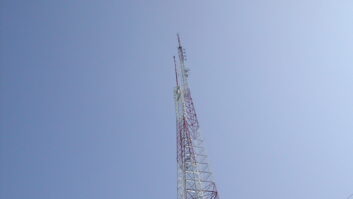
The author works on rebuilding the front control panel of the Gates FM-10H3.
Listener-supported WAWZ(FM) was nearing the end of its annual fundraiser, having reached $22,000 of the $30,000 goal. With 15 minutes to go before the end of the “Sharathon,” a listener from nearby Elizabeth, N.J., called to say she had inherited $8,000 in stock and was donating the proceeds to the station. WAWZ would be able to purchase a new transmitter.
A few months later, the transmitter was tested at the factory in Quincy, Ill., and delivered to WAWZ(FM) in Zarephath, N.J. It was put in service by Chief Engineer Alan Chambers, assisted by Elmer Smith.
This was early 1975. Gerald Ford was president; I was in first grade celebrating my 6th birthday.
The transmitter was a Gates Radio FM-10H3, Serial Number 89971.
Lost in the shuffle
By 1989 the station had grown, and management decided an upgrade was in order. WAWZ took delivery of a QEI FMQ20000B; the Gates was relegated to the role of backup.
In 2004, when WAWZ got the go-ahead to build a much-needed new tower, it also took the opportunity to again upgrade to a new solid-state, HD-ready Broadcast Electronics FMi-1405. The QEI was sold; but the old Gates remained in a corner of the transmitter building, disconnected — too big and heavy to use as a doorstop.
At that time I’d been working for WAWZ as assistant engineer to Chief Engineer Ron Habegger.
Ron had, like most engineers his age, cut his teeth on similar transmitters. In fact, his first CE job had him working on a Gates FM-1H, essentially a scaled down version of ours.

PA stage with the 4CX10000D tube.
Since I hadn’t had a lot of experience working with older transmitters (actually, I had none!), we decided to restore the Gates to her former glory, or as close to her former glory as we could get. It would be a great way for me to learn, and would provide the station with a backup transmitter again.
To start with, it needed a good cleaning. Years of dust and debris had to be vacuumed out of the innards. We also completely dismantled the front panel.
Ron painstakingly rebuilt the switches, gave the control panel itself a new coat of paint and even replaced the Plexiglas over the meters.
In the meantime, I took all the RF connectors and hardware including the six-foot-long harmonic filter, tarnished from years of neglect, and polished them. Ron also removed much of the internal wiring from its conduits inside the transmitter, cleaned it and properly rerouted it. Slowly but surely, the Gates began to look like a transmitter again.
But would it sound like one?
On Feb. 27, 2009, we connected the output of the Gates to a dummy load, turned on the breakers to send AC and hit the “Filament On” button. The blower — the original blower motor — started up; and the multimeter on the front panel immediately showed 7.5 Volts, just what the spec sheet called for.
We let it idle for a while, breaking in the new tube we installed. Then came the moment of truth. Hitting the “Plate On” button would bring this beast to life.

Don’t try this at home! Ron reached for the button, and we held our breath.
Boom!
The next thing we knew we were standing in the dark.
I immediately looked behind me, where our main BE transmitter was. Much to my relief, it was still on.
After gathering our wits, we found a flashlight and checked the breaker panel for the Gates. Not only had it tripped the two breakers for the Gates power supply; it had tripped the main disconnect for that panel, taking out the lights and air conditioning. Ron reset it and got the lights back on.
We both noticed a slight burning smell in the air. “I don’t even want to look,” he moaned.
We made our way behind the Gates, convinced we were about to survey thousands of dollars in damage. We found the problem: One of the 60 A cartridge fuses for the 208 V, three-phase supply had blown apart. Not just blown — blown apart!
Fortunately, that was the extent of the damage. The fuse had served its intended purpose in spectacular fashion. But what had gone wrong? We decided to quit for the day to regroup.
Ron later discovered that we had miswired the primary on the 6000 V plate transformer. It’s a multiple tap transformer designed to accommodate 208, 230 or 240 V supplies. The markings on each tap were hard to read inside the cabinet, and spaced apart equally, so basically, instead of a 208 V winding, we had a 12 V winding. Oops!
After beating ourselves up for that and rewiring the plate transformer, we tried again.
This time we didn’t blow anything apart, but it made the most awful noise. The Gates uses a step-start circuit to prevent current in-rush to the plate transformer from blowing fuses. (Too bad it can’t prevent sleep-deprived engineers from blowing fuses!) The step-start relay is designed to delay the three-phase supply by a fraction of a second. The relay was chattering loudly, but still managed to serve its purpose. It sounded terrible, but it was working.
We set about tuning it up. The old Gates TE-3 Solid-Statesman exciter was a bit reluctant to behave, but with some coaxing (some of the percussive nature) we managed to get it happy enough to complete the tuning procedure.

The output loading control repair with rubber hose and clamps. We decided that, since we were running the Gates at 208 V instead of the specified 240 V, we might get away with bypassing the step-start relay. Ron left that task to me, and on April 9, I successfully started her up without it.
Other than the blower noise, it was quiet. I had to double-check the meters to make sure it was actually running; but there it was, putting out a bit over 7.5 kW. Not quite full power, but enough to keep us on the air to most of our listeners.
Another problem
In the process of subsequent tunings, we suffered a bit of a setback when the output loading control knob suddenly began to spin freely. Not good.
Removing the access panel revealed the problem. The control is connected to the PA cavity using a linkage consisting of a short metal shaft between two universal isolation joints. Each joint is made from a cross-shaped piece of porcelain and some thin bands of aluminum (for flexibility). The aluminum bands on one joint had gotten twisted and tore loose.
After mulling over how to rebuild the joint, I tried using a short piece of rubber hose and two hose clamps. It worked! Rube Goldberg would be proud.
Although the TE-3 Solid-Statesman exciter behaved long enough to tune the transmitter, it simply wouldn’t stay on frequency. Fortunately, our BE FMi-1405 was shipped with a spare exciter, a BE FM-50. We were able to mate the FM-50 with the Gates. A little retuning and all was well. Getting the TE-3 to stay put was my next challenge.
The next step was to interface the Gates with our Burk ARC Plus remote control system. The wrinkle here was that, while the Burk uses low voltages (5–24 V) for its control interface, the Gates uses high voltages, as much as 115 V. Using high-voltage relays we were able to get them properly acquainted. We’d be able to power up the Gates from our cell phones if for some crazy reason the BE FMi-1405 went AWOL.

Curt Yengst and CE Ron Habegger show off the restored Gates. Finally, on May 15, 2009, the moment we waited months for had arrived. The Gates was disconnected from the dummy load and connected to our auxiliary antenna. Just after midnight, we shut down the FMi-1405 and fired up the Gates. The radio crackled for a second, and just as we had hoped, WAWZ’s signal came blasting from the speakers. It performed flawlessly!
So now she sits quietly in the corner, just in case we need her. Since the restoration there have been a couple times we did, when the BE needed to be shut down for maintenance.
The old Gates is a beautiful and welcome addition to our present-day broadcast arsenal. Sure, she’s practically an antique by today’s standards, but that’s part of the appeal. While the design is simple, you still have to know what you’re doing.
The modular design of the BE FMi-1405, with its multiple redundancies, can almost spoil a young engineer. Having something like the Gates around not only provided an education in transmitter design; it made me appreciate what veterans in this field had to know to keep their stations on the air.
The author is assistant engineer at WAWZ(FM) in Zarephath, N.J.












